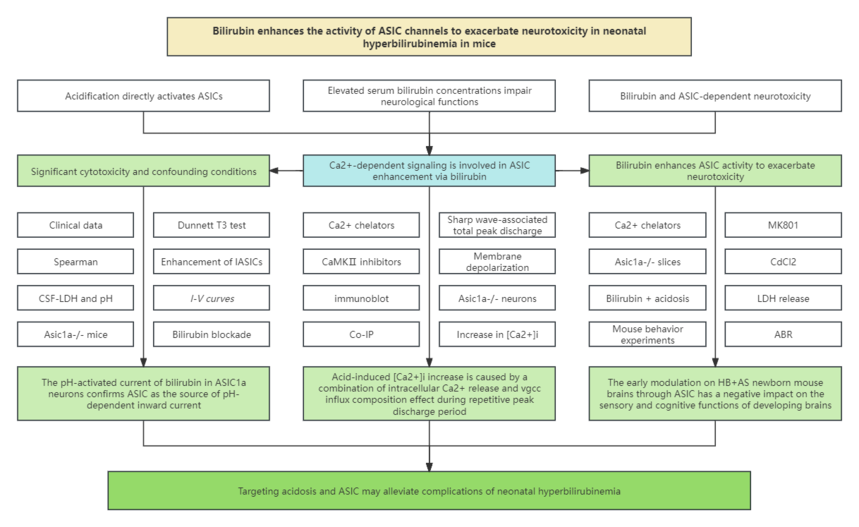Please click the button below to go to our email login page
|
IF15+/Science subsidiary journal! Yin Shankai/Shi Haibo’s team in Shanghai Jiaotong University reveals the “real culprit” behind neonatal jaundice combined with acidosis and neurotoxicity!Jaundice refers to the yellowish discoloration of the skin and mucous membranes caused by hyperbilirubinemia. So, what are some research designs regarding jaundice?
Next, we will share a paper titled Bilirubin enhances the activity of ASIC channels to exacerbate neurotoxicity in neonatal hyperbilirubinemia in mice published on SCIENCE TRANSLATIONAL MEDICINE with a high IF of 15.8, hoping to inspire you from different aspects.
1. Research background 1.1 Neonatal hyperbilirubinemia, manifested as increased concentration of serum bilirubin, damages neural function and morphology. 1.2 The acidification caused by ischemia and hypoxia can directly activate acid-sensing ion channels (ASICs), which are members of the denatured/epithelial sodium channel superfamily. 1.3 These channels constitute homotrimers and heterotrimers of ASIC subunits: 1a, 1b, 2a, 2b, 3 and 4, of which ASIC1a, 2a and 2b are the main subunits found in central nervous system. 1.4 The current conceptual paradigm suggests that acidosis enhances bilirubin overload in the neonatal brain, but the relationship between bilirubin and ASIC-dependent neurotoxicity is still unknown.
2. Technical route
3. Research results 3.1 Cross-correlation analysis between blood bilirubin and pH values with hyperbilirubinemia and/or acidosis cerebrospinal fluid of infants. 3.2 Bilirubin enhances ASIC currents in a pH-dependent and voltage-dependent manner. 3.3 Ca2+-dependent signaling participates in ASIC enhancement via bilirubin. 3.4 Bilirubin and acid have synergistic effects on neuronal excitability. 3.5 Bilirubin amplifies acid-induced intracellular Ca2+ transients. 3.6 Bilirubin exacerbates neurotoxicity by enhancing the activity of ASIC. 3.7 Neonatal hyperbilirubinemia and acidosis in mice cause long-term damage to brain function.
4. Conclusion This study verified that in infants with hyperbilirubinemia and acidosis, the concentration of cell death marker LDH in CSF increases and is more strongly correlated with the severity of acidosis rather than the increase in bilirubin concentration. In neurons of newborn mice, bilirubin displays limited toxicity and elevates ASIC activity, leading to increase of Ca2+ concentration, spike firings, and cell death. Moreover, neonatal conditioning with concurrent hyperbilirubinemia and hypoxia-induced acidosis can promote long-term impairments in learning and memory and complex sensorimotor functions in vivo; however, these damages are mitigated in ASIC1a-deficient mice. The above findings indicated that targeting acidosis and ASICs may attenuate neonatal hyperbilirubinemia complications. |

